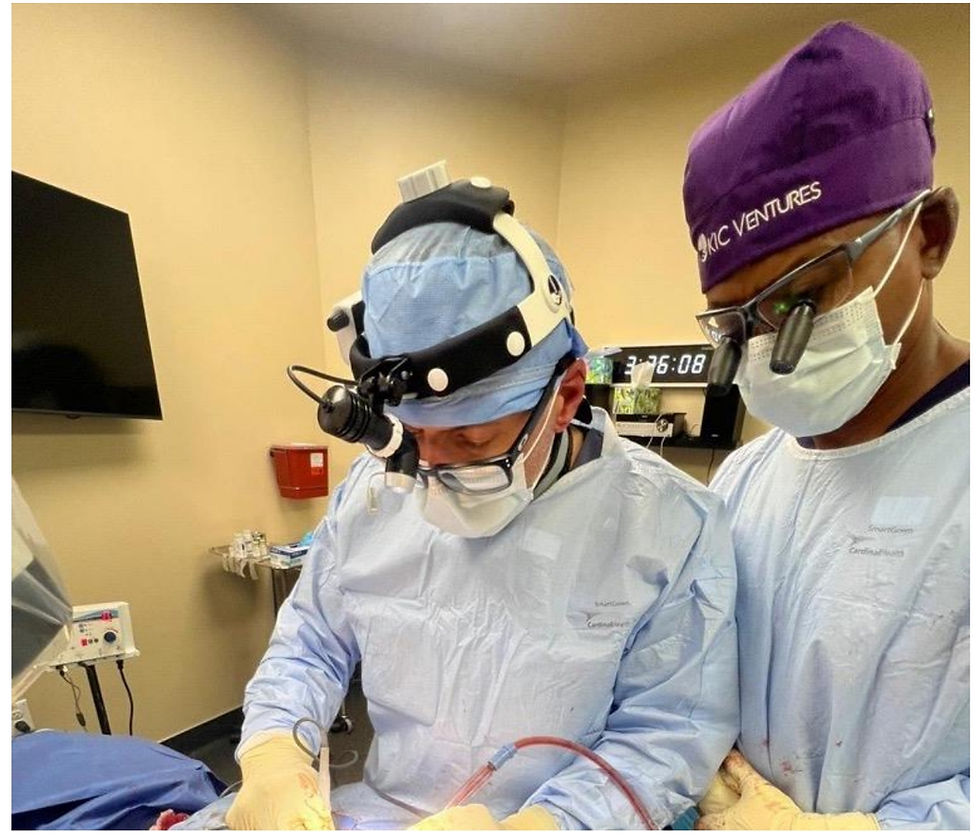Total Disc Replacement: An Alternative for Preserving Motion in Spine Care
- sukanyarao
- Oct 6
- 4 min read
Written by Sukanya Chebrolu, MS and Chukwunonso C. Ilogu, MD, MS of the LESS™ Society If you live with daily back or neck pain, you’re not alone. Millions of people worldwide face similar challenges, often caused by changes in the spine that come with age, lifestyle, or injury. One of the most common conditions behind persistent spine pain is degenerative disc disease (DDD) (1,2).
Understanding Degenerative Disc Disease (DDD)
DDD occurs when spinal discs, the cushions between the bones (vertebrae) of the spine, gradually lose hydration and flexibility. This can lead to:
Ongoing back or neck pain.
Stiffness or reduced range of motion.
Pain that worsens with sitting, bending, or lifting.
Radiating pain, numbness, or tingling if nerves are affected (3).
Diagnosis and Treatment Options
A diagnosis usually begins with a physical examination, a review of symptoms, and imaging tests like X-rays or MRI scans (4). These help doctors confirm whether disc degeneration is the cause of pain. Conservative treatments are almost always recommended first. These include:
Physical therapy to strengthen core and back muscles.
Medications to reduce pain and inflammation.
Epidural or facet joint injections for temporary relief.
When these methods no longer provide lasting benefit, surgery may be considered. Traditionally, the main surgical option has been spinal fusion.
Spinal Fusion vs. Total Disc Replacement (TDR)
Spinal Fusion: Permanently joins two or more vertebrae to stabilize the spine and reduce pain. While effective, it also restricts movement at the treated level and may increase strain on adjacent segments over time.
Traditional Total Disc Replacement (TDR): In contrast, TDR aims to preserve motion at the operated level. Articulating ball-and-socket TDRs for example, ProDisc® was developed to restore mobility and serve as a mechanical alternative to fusion. These devices can help maintain range of motion and reduce stress on neighboring segments.
However, ball-and-socket TDRs also have key limitations. They lack true shock absorption, may allow excessive segmental movement, and are associated with a risk of heterotopic ossification (HO) a condition where unwanted bone formation can reduce mobility over time.
The AxioMed™ Freedom Disc™: A More Natural Approach
The AxioMed™ Freedom Disc™ takes motion preservation a step further. Instead of using a mechanical articulating joint, it is a one-piece viscoelastic core designed to mimic the natural disc’s flexibility and shock absorption.
This design provides:
Controlled, multi-directional motion that mirrors natural spinal movement
Shock absorption that cushions spinal loading forces
Reduced stress on adjacent levels for long-term biomechanical balance
By replicating the mechanical properties of a healthy disc, the Freedom Disc offers a more physiological motion-preserving solution, addressing the shortcomings of traditional ball-and-socket designs.
Below is the image of AxioMed™ viscoelastic disc replacement device, designed as a one-piece elastomeric disc that moves and absorbs shock like a healthy spinal disc, offering a more natural motion than traditional ball-and-socket devices.
Image Source: https://www.axiomed.com/technology
Patient-Centered LESS™ Principles in Spine Surgery
When it comes to total disc replacement (TDR), surgery is just one part of the bigger picture of care. The Less Exposure Spine Surgery (LESS) approach focuses on applying our R.E.P philosophy to masterful surgical techniques that minimize disruption, reduce risks, and support faster recovery.
Restore Function – Helping patients regain movement and reduce pain so they can return to normal activities.
Early Intervention – Addressing spine problems before they become severe, which may help avoid more invasive surgeries later on.
Preserve Anatomy – Protecting healthy tissues and structures by minimizing unnecessary damage during surgery (6).
TDR naturally fits with these principles. It works to restore natural motion, provides a timely option for painful disc disease, and helps preserve surrounding anatomy compared to traditional fusion procedures. If you’re exploring options for back pain relief, talk to your spine specialist about whether TDR with the LESS™ approach may be right for you. This motion-preserving surgery is designed to reduce pain, protect healthy tissues, and help you return to your daily activities with greater comfort and confidence.
Frequently Asked Questions (FAQs)
Q1. Who might benefit from Total Disc Replacement (TDR)?
A1. Patients with disc-related pain at one or two levels, without severe arthritis, instability, or osteoporosis, may be considered for TDR. A spine specialist will decide based on clinical evaluation and imaging.
Q2. How does TDR compare with spinal fusion?
A2. Fusion stabilizes the spine but removes motion at the treated level, which may increase stress on nearby segments. Traditional TDR preserves some movement but often in a mechanical, joint-like pattern due to its ball-and-socket design. The AxioMed™ disc is different it uses a one-piece viscoelastic core to mimic the natural disc’s ability to absorb shock and move in all directions, offering a closer match to healthy biomechanics.
Q3. What can patients expect after TDR surgery? A3. Recovery varies, but many patients return to daily activities sooner than with fusion. Rehabilitation and physical therapy are important for regaining strength and flexibility.
References
Taher F, Essig D, Lebl DR, Hughes AP, Sama AA, Cammisa FP, et al. Lumbar degenerative disc disease: current and future concepts of diagnosis and management. Adv Orthop 2012;2012:970752. https://doi.org/10.1155/2012/970752.
Battié MC, Joshi AB, Gibbons LE, ISSLS Degenerative Spinal Phenotypes Group. Degenerative Disc Disease: What is in a Name? Spine (Phila Pa 1976) 2019;44:1523–9. https://doi.org/10.1097/BRS.0000000000003103.
Kirnaz S, Capadona C, Lintz M, Kim B, Yerden R, Goldberg JL, et al. Pathomechanism and Biomechanics of Degenerative Disc Disease: Features of Healthy and Degenerated Discs. Int J Spine Surg 2021;15:10–25. https://doi.org/10.14444/8052.
Farshad-Amacker NA, Farshad M, Winklehner A, Andreisek G. MR imaging of degenerative disc disease. Eur J Radiol 2015;84:1768–76. https://doi.org/10.1016/j.ejrad.2015.04.002.
Chin KR, Lubinski JR, Zimmers KB, Sands BE, Pencle F. Clinical experience and two-year follow-up with a one-piece viscoelastic cervical total disc replacement. J Spine Surg 2017;3:630–40. https://doi.org/10.21037/jss.2017.12.03.



Comments